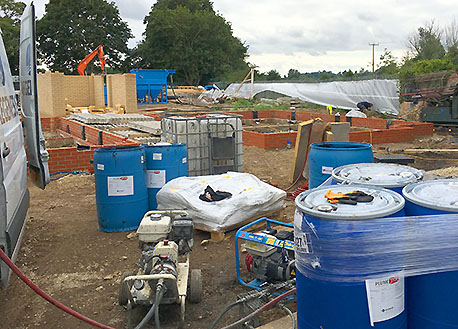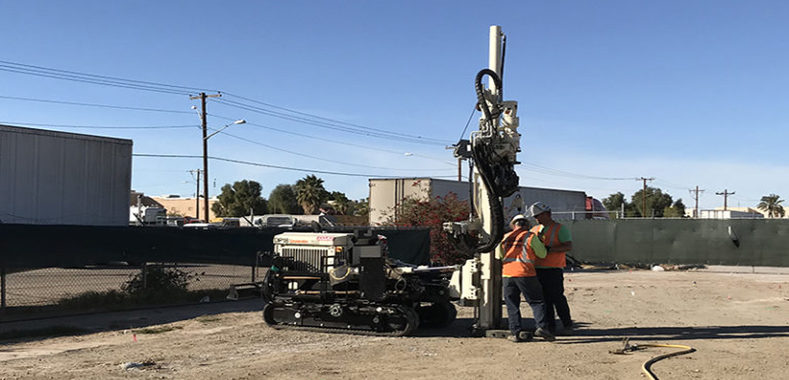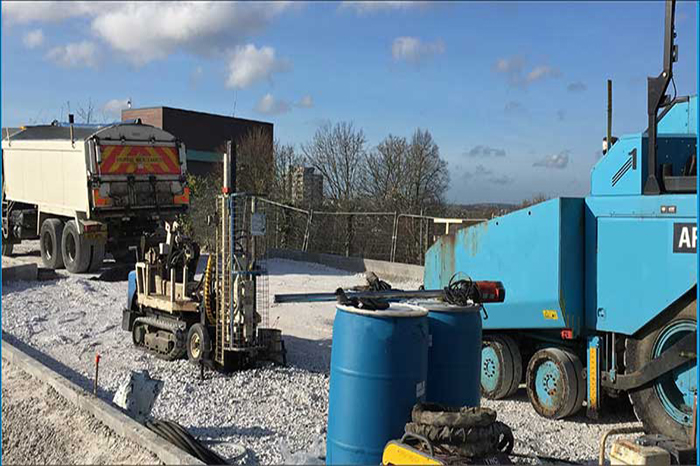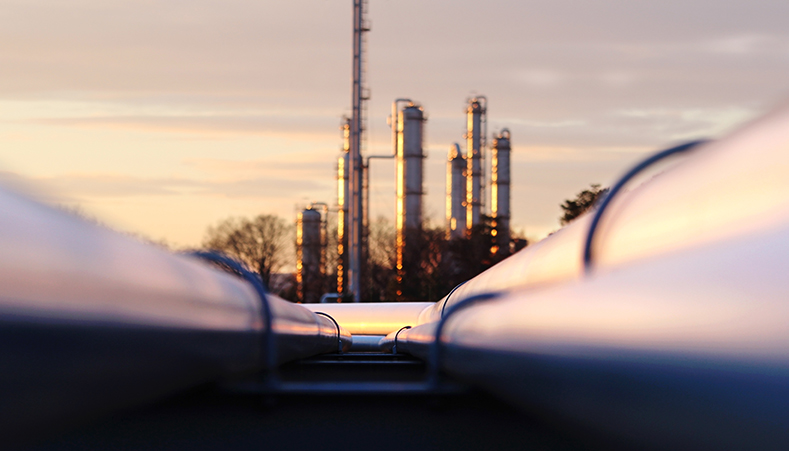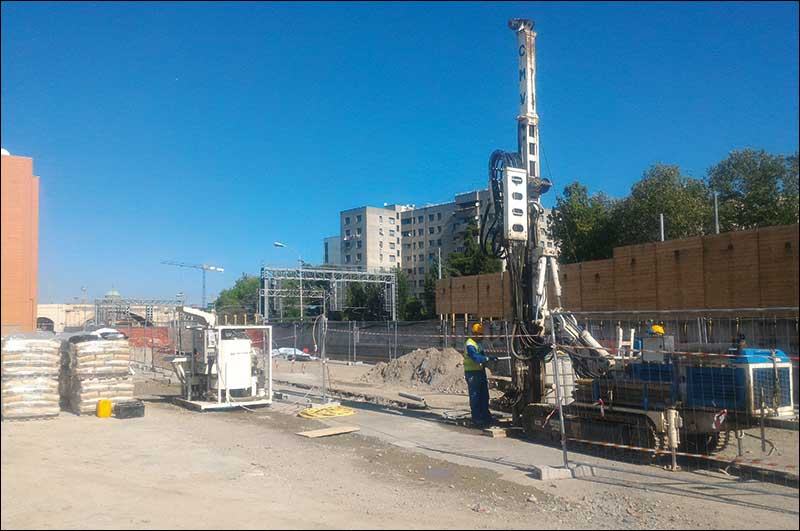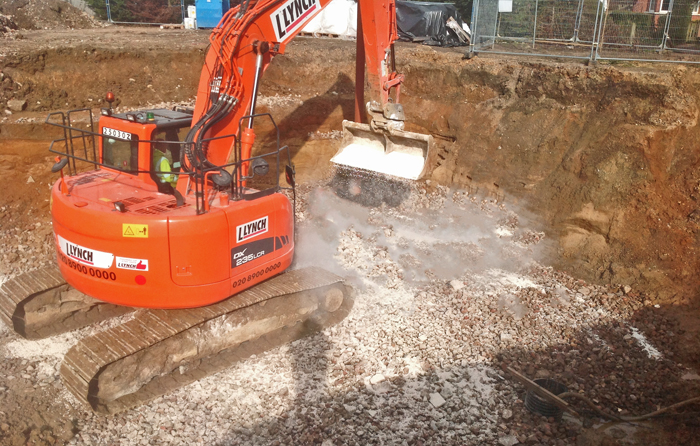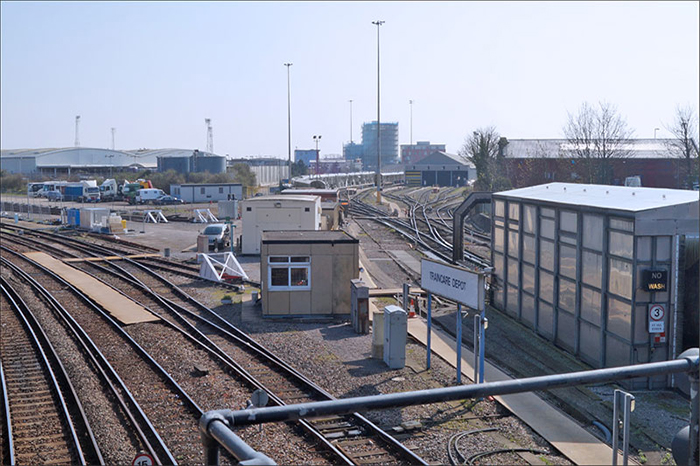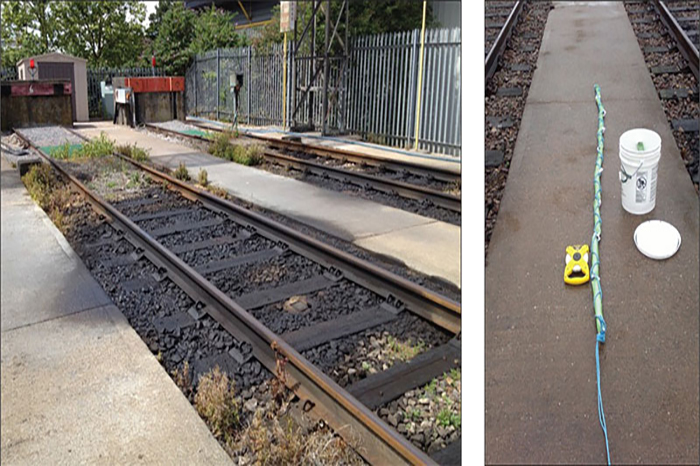Redevelopment of former gas works unlocked by combining technologies
Integrated remediation strategy provides rapid and cost-effective clean up
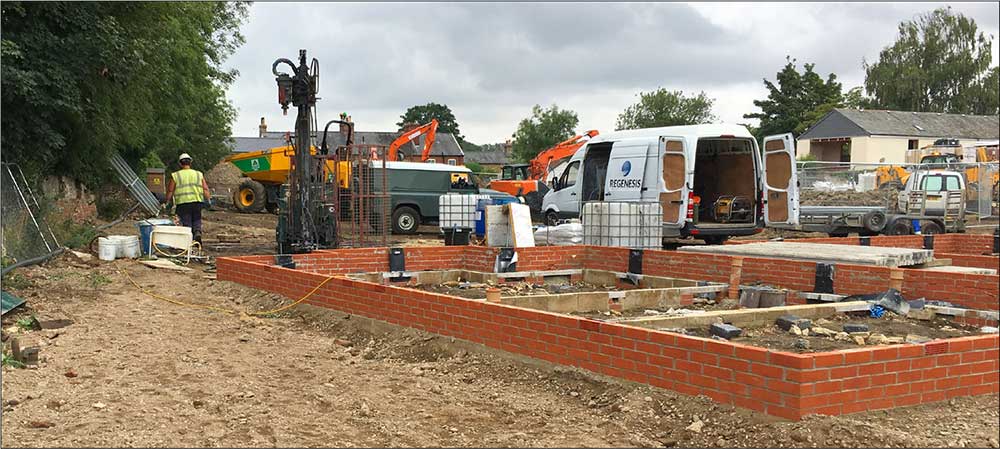
- During the construction of multiple residential dwelling it became apparent that a historical gas works had previously occupied the site.
- A targeted site investigation needed to be completed quickly to identify the areas requiring remedial action, enabling construction to continue in plots outside of the plume.
- A combined remedial strategy was required to address soil, LNAPL, DNAPL and dissolved phase contamination.
- The implementation of the treatment had to be completed around partially completed housing and live underground services.
- The remedial works had to be completed quickly in a manner as to not impact the build program.
- The strategy needed to provide appropriate protection to both human health and controlled waters.
- The need to respond and act quickly required excellent communication and good working relationships to be established between the consultant, stakeholders, regulators and multiple specialist remediation contractors and suppliers.
4m 44s reading time
Remedial Approach
A wide range of remediation technologies were deployed sequentially and in parallel to provide the most rapid and cost effective clean up:
- Ex situ bio-piling of hydrocarbon impacted soils
- LNAPL skimming
- Pump and treat (P&T) of dissolved phase contamination
- DNAPL pumping and settlement/collection
- Enhanced abstraction of contaminant mass using PetroCleanze
- In Situ chemical oxidation (ISCO) using RegenOx, which is compatible with footings and services already in place
- Accelerated aerobic natural attenuation using ORC Advanced slurry
- Accelerated aerobic natural attenuation using a pelletised oxygen-release compound (ORC Advanced) placed in the backfill
- PlumeStop Liquid Activated Carbon injection to install a subsurface activated carbon filter to adsorb and biologically degrade dissolved phase contamination
- Gas vapour membrane installation
Ex situ treatment
The impacted materials within the unsaturated zones within Plume A and B were excavated and placed in a biopile for onsite treatment (Figure 1). Nutrients were added and the biopile was turned until remedial targets were achieved. The soils were then backfilled under the CL:AIRE Code of Practice. Prior to backfill with the remediated soils, ORC Advanced Pellets were added to the base of the excavation. This provided a source of dissolved oxygen for up to a year, stimulating the growth of an effective aerobic biomass and accelerating the degradation of the petroleum hydrocarbon contamination.
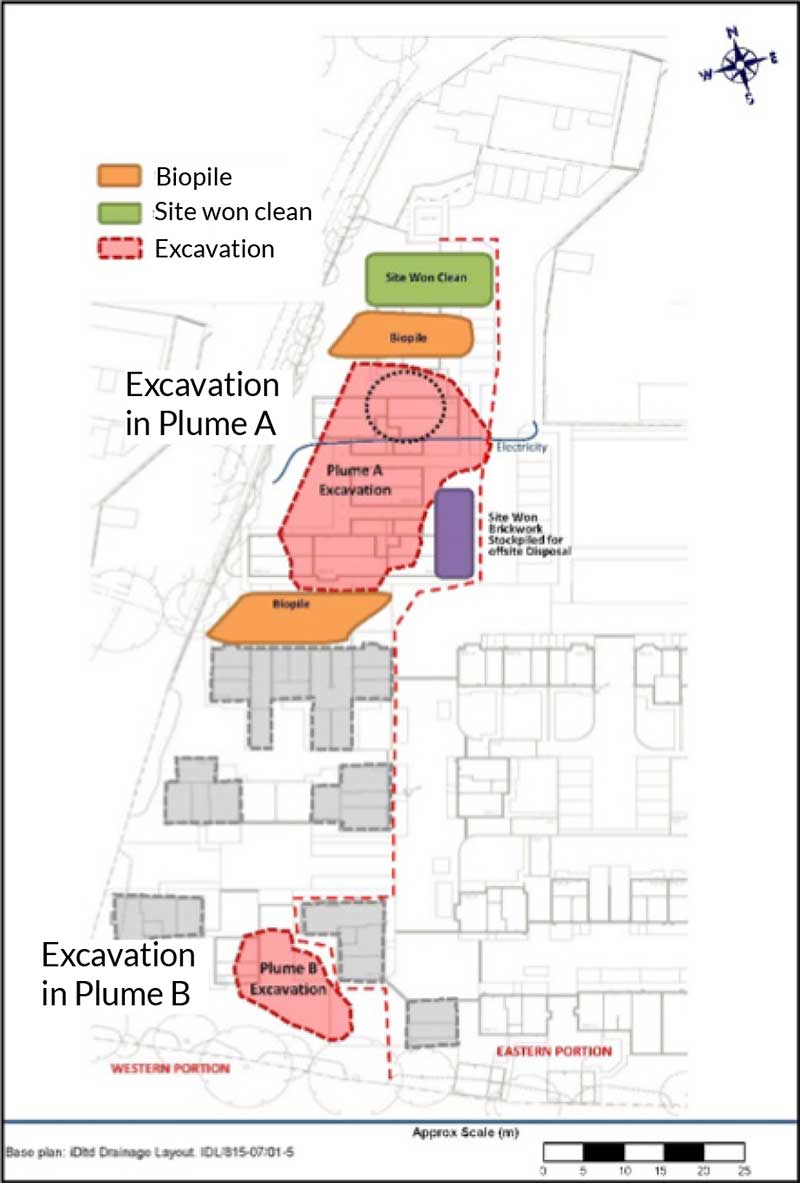
In Situ Treatment
The southern part of Plume A was made inaccessible by footings and services; here in-situ treatment was completed accommodate these obstructions without compromising treatment efficacy. Within Plume B, where high levels of contamination had been encountered (Figure 2), several in situ remedial actions were taken as appropriate to concentration, location and sequence in the strategy:
- REGENESIS injected PlumeStop, a micron-scale colloidal Liquid Activated Carbon substrate along the western margin of the site via direct push to protect the offsite surface water. PlumeStop creates a subsurface activated carbon filter which adsorbs the contaminant influx, which is then degraded by the microbial growth on the carbon biomatrix. Biological degradation was also accelerated through co-application of ORC Advanced and the presence of the pelletised ORC placed in the base of the excavation upgradient, providing a controlled release of oxygen.
- Where LNAPL and high dissolved phase concentrations were observed, a network of injection boreholes were installed by Rake Remediation/REGENESIS. Many of the wells were installed by removing suspended floors and lifting in a mini-rig to complete the drilling beneath partially constructed dwellings. Through these wells, multiple applications of RegenOx were completed. This in situ chemical oxidant was chosen as it was safe to handle on this busy site and would not corrode services installed at the site, nor would it be detrimental to the concrete footings.
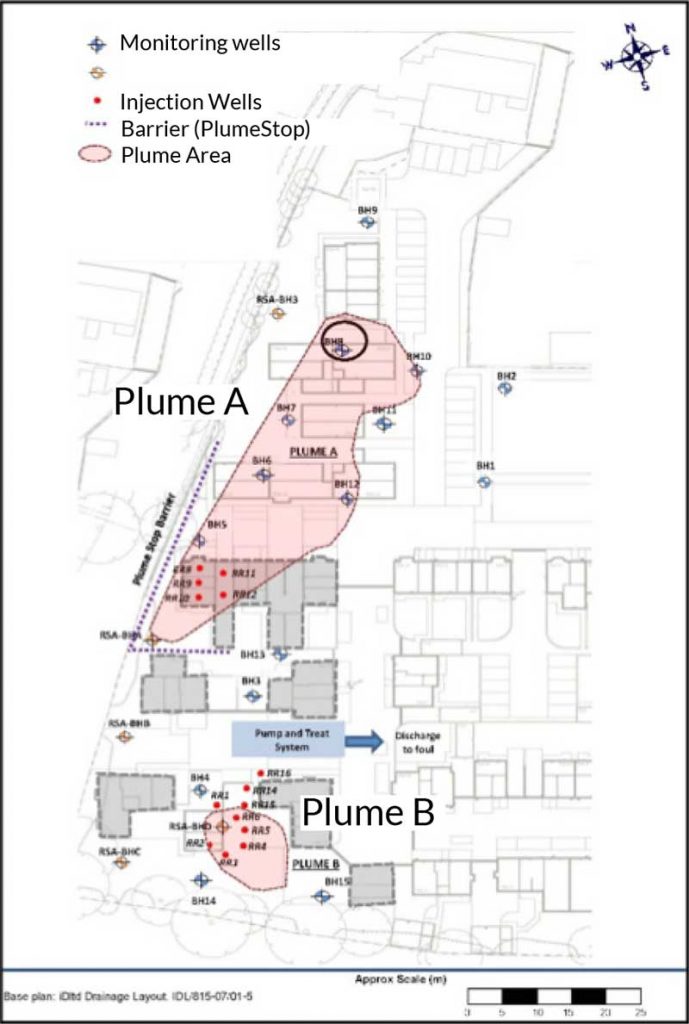
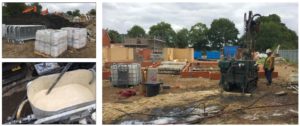
- Following the ISCO, ORC Advanced slurry was injected to enhance the natural attenuation (ENA) of the residual dissolved phase contamination to low levels.
- In Plume B, high levels of contamination in the form of both L- and DNAPL were encountered. This was removed using a P&T system augmented with PetroCleanze, an inorganic surfactant that uses a high pH, carbonates, silicates and partial oxidation to remove contaminants from soils. The PetroCleanze was injected to produce a temporary desorption event, which once observed, allowed the P&T system to be switched back for a short period to remove the contamination. This process was repeated three times to maximise the efficacy of the P&T and shorten the treatment programme.
- Once the NAPL was removed, multiple rounds of RegenOx were completed, followed by ORC Advanced via injection through wells.
- Long term groundwater monitoring programme was put in place to monitor the effectiveness of the clean-up.
Results
The following graphs (Figures 7 and 8) show the variations in concentrations for selected priority contaminants of concern over the monitoring period for Plume A and B. These show a marked reduction in the hydrocarbon dissolved phase concentrations over time, with compliance achieved with the remedial criteria.
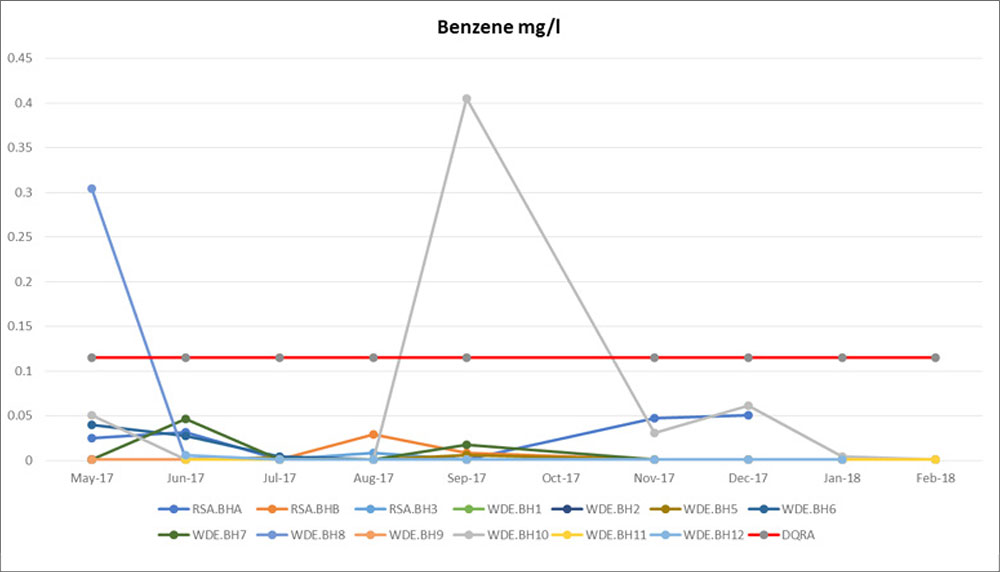
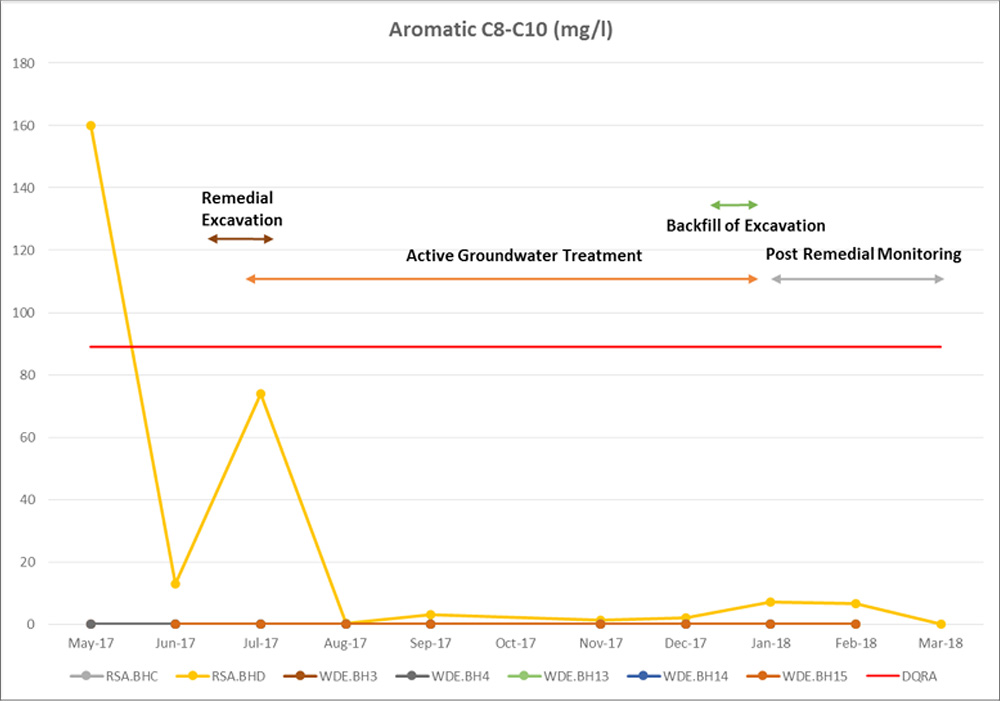
Conclusion
Complimentary remedial technologies were combined successfully to achieve:
- Contaminant mass reduction to below remedial targets in the soil and groundwater within 6 months.
- Protection of onsite and offsite receptors.
- Written confirmation by the Environment Agency that they ‘agree with (the reports’) conclusions’ and that ‘development may proceed’.
- Remediation completed on a tight budget – as remediation had not been foreseen by the developer.
- Ex-Situ remediation of soils and their reuse on site under the CL:AIRE CoP avoided offsite disposal of ~800m3 to landfill.
- In Situ enhancement of the P&T system, minimising the time, cost and volume of abstraction required.
- By combining the technologies intelligently, both simultaneously and sequentially, the programme length was minimised – allowing construction to continue within only 6 months.
Remediation Goals Achieved with Combined Remedy Approach
Soil Mixing and ISCO Approach Achieves Arizona DEQ Closure Levels
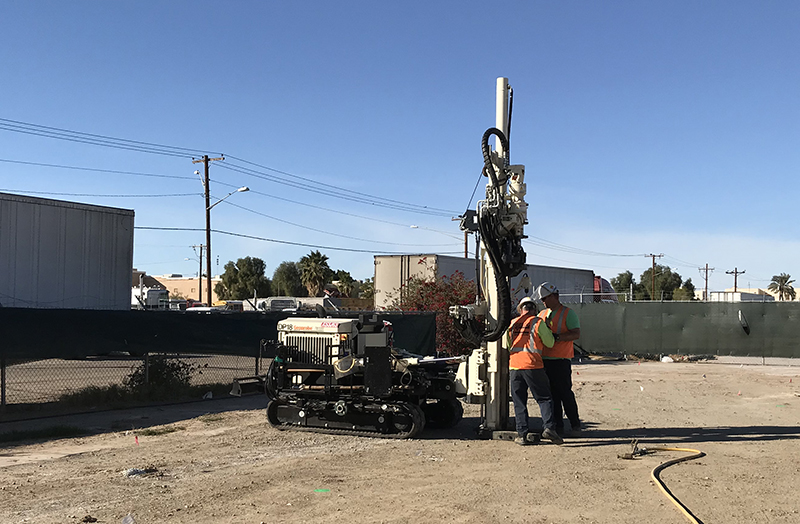 This case study reviews an active Underground Storage Tank (UST) case with the Arizona Department of Environmental Quality (ADEQ), where the site needed to meet ADEQ closure levels quickly in order to seek risk-based closure as part of a property transaction. After performing remedial assessment activities, the consulting firm Antea Group selected a combined remedy approach from REGENESIS, which included soil mixing using RegenOx® and H2O2 in the source zone and ISCO injections using PersulfOx® in the core plume. The solution from REGENESIS achieved ADEQ Closure levels for the site and now Antea Group is seeking a risk-based closure.
This case study reviews an active Underground Storage Tank (UST) case with the Arizona Department of Environmental Quality (ADEQ), where the site needed to meet ADEQ closure levels quickly in order to seek risk-based closure as part of a property transaction. After performing remedial assessment activities, the consulting firm Antea Group selected a combined remedy approach from REGENESIS, which included soil mixing using RegenOx® and H2O2 in the source zone and ISCO injections using PersulfOx® in the core plume. The solution from REGENESIS achieved ADEQ Closure levels for the site and now Antea Group is seeking a risk-based closure.
This case study features the following:
- Significant contaminant reductions achieved in both the source area and core plume
- 8-10 weeks of time saved compared to alternative approaches
- $500,000 saved in project costs compared to alternative Electrical Resistance Heating (ERH) approach being considered
Galligu and TPH Contaminated Site Remediation in Runcorn, UK
Summary
Wildgoose Construction’s redevelopment of a former bus depot into commercial/retail, including a new public house for Marston’s, posed unique and complex challenges. Geotechnical and Environmental Associates Ltd (GEA) identified that each step in the solution process would have a follow-on effect, so a well thought-out, integrated approach was crucial for the project’s success.

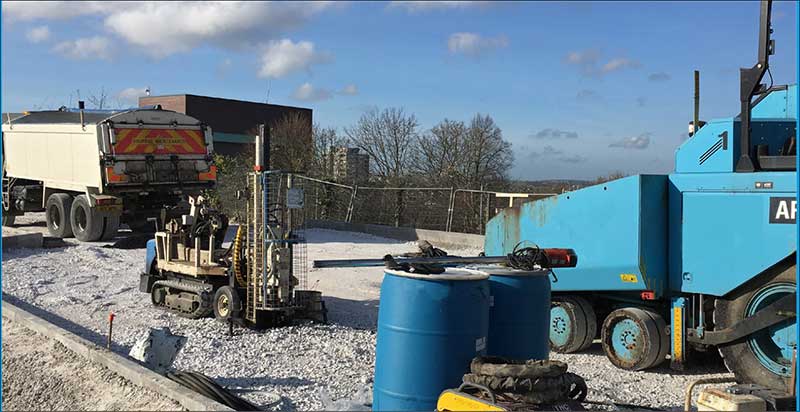
Fig. 1 – PlumeStop barrier injection near site boundary
The site comprised a hillside covered by industrial waste from the Leblanc process comprising several metres of galligu above a black ash layer which was underlain by cohesive glacial till. Two geoenvironmental issues needed addressing:
- Stability: the galligu had a weak structure, with a ‘toothpaste’ consistency in parts;
- TPH contamination; leaking underground storage tanks (UST)s onsite resulted in fuel infiltrating the subsurface and moving offsite via perched water in an ash layer beneath the galligu. The downgradient boundary comprises a steep slope to the canal where the contaminated groundwater egressed at ground-level, polluting the waterway.
4m 42s reading time

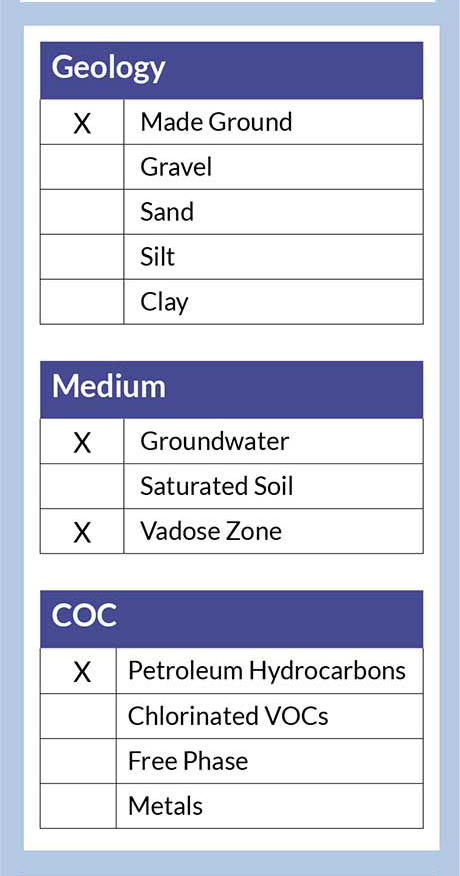
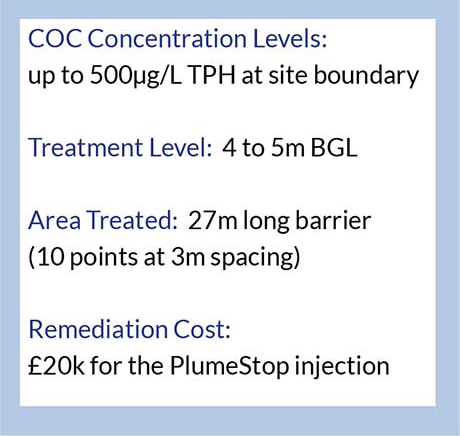
An integrated solution: Soil/cement mixed panels were used to support structures, with a soil/cement mixed mattress covering the entire site, as a load transfer platform. Installation of these panels altered the groundwater flow, which therefore needed modelling to ensure the contaminant treatment could be targeted accurately.
Modelling groundwater flow through anthropogenic waste and man-made installations presented a challenge, as models are designed for more homogeneous and isotropic conditions. However, it was shown that groundwater would be raised and channelled towards the panel ‘wall’ at the boundary. Here the groundwater would funnel through gaps at a higher velocity.
An innovative Liquid Activated Carbon substrate was used to integrate with the panels, which required no maintenance and provided effective treatment in the extremely bio-toxic environment created by galligu. This subsurface carbon-filter entirely prevented contaminant egress from the site.
Integrated Geoenvironmental Solution
The structure of galligu varied across the site: from fused crystalline ‘rock’ in upper areas, to a weak ‘toothpaste’ consistency at depth – unsuitable to build on. Previous settlement caused hydrocarbon leaks from broken pipes, resulting in the bus depot closure. Potential settlement prevented the use of a raft foundations. In addition, the presence of a high pressure gas main prevented the use of a piling solution. Therefore a soil/cement panel solution was piloted and then installed full scale by Deep Soil Mixing Ltd, using in situ mixing equipment (see figure 5 and 6).
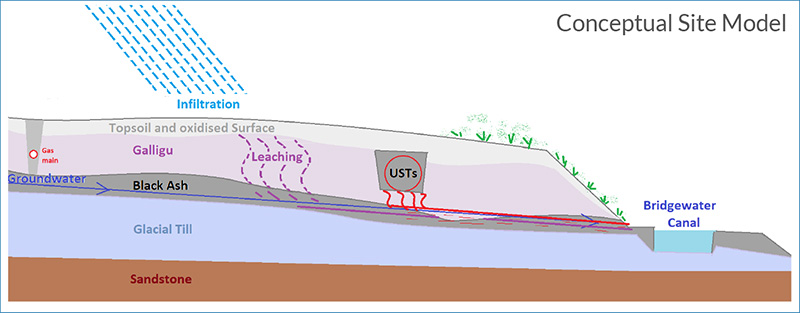
Fig. 2 – Conceptual Site Model in Section

Fig. 3 – Remedial Strategy in Section
The geotechnical solution created a new challenge: to understand how the cement stabilised columns would alter the groundwater flow pattern across the site. This was crucial to know, in order to determine where contaminant egress may occur at the site boundary.
Galligu creates strongly alklaline, arsenic rich, reduced conditions in the subsurface. This inhibits biological degradation, resulting in ongoing persistence of TPH. This chemistry prevents typical remedial approaches to be taken as the remedial solution would have to: not react with the cement, galligu or ash; capture the hydrocarbons in the toxic conditions produced by the galligu; work for decades, until the residual secondary source is depleted, without power, pumping or further action.
When PlumeStop Liquid Activated Carbon (LAC) was chosen, the placement of this underground filter needed to be carefully considered. At the boundary, the groundwater flow was extremely fast through the gaps. Hence, by moving the barrier into the site, the slower groundwater allowed for a longer treatment time in the PlumeStop. The PlumeStop barrier length was guided by the modelling, to transect the entire contaminant plume. REGENESIS provided bespoke design work to match the predicted groundwater flow and contaminant levels (i.e. the contaminant flux).
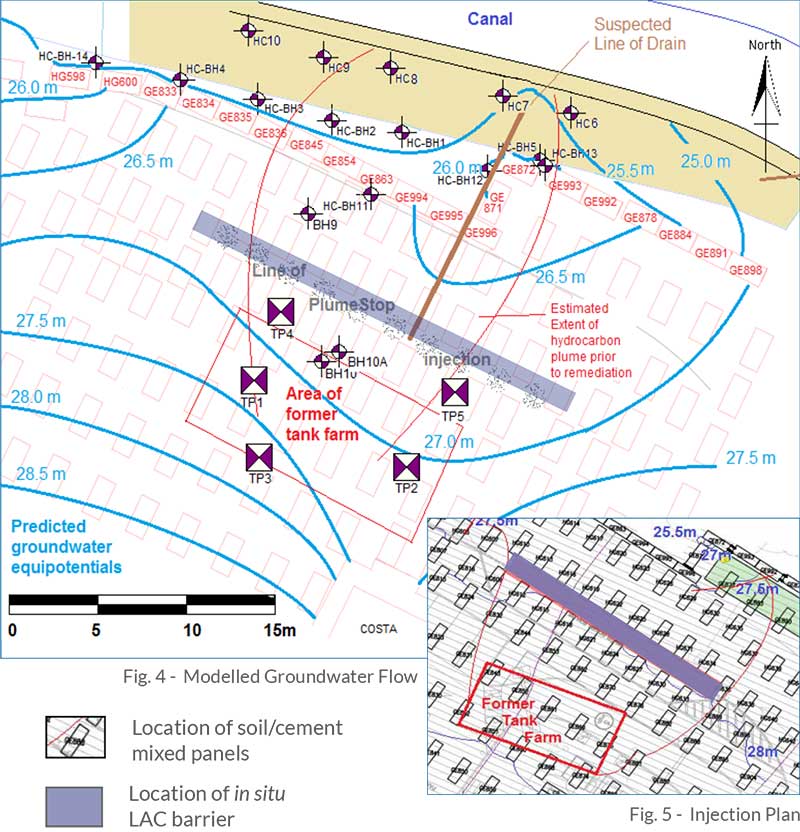
Application
REGENESIS worked with GEA and their client to ensure the design matched their requirements. REGENESIS also managed and completed the injection works onsite using direct push injection, and then provided a completion report and warranty.
All work was completed on a busy construction site, with a high-pressure gas main and large easement.

Results
Following injection of the PlumeStop across the width of the predicted contaminant plume, the TPH concentrations at the site boundary were dramatically reduced by 98%. Although not the main focus of the treatment, low levels of PAH were also reduced to non-detect.

Fig. 14 – TPH concentrations at site boundary before and after PlumeStop barrier treatment
Conclusion
This integrated geoenvironmental solution was highly successful, delivering a number of key achievements:
- Galligu is often treated ex-situ, which was not practical in this situation. The soil/cement stabilisation approach provided an economical solution to the geotechnical problems presented by Galligu, whilst encapsulating the contaminants within it and minimising future leaching. Being a low disturbance technique, it also permitted treatment alongside a high-pressure gas main where piling was not permitted. Groundwater modelling of the altered flow pattern was required to allow the design of the remedial scheme. Due to the inevitable uncertainties associated with groundwater flow through the ash layer this modelling was carried out using a low cost electrical analogue modelling technique.
- The remedial scheme allowed the project to proceed within budget and was delivered on time.
- Treatment of petroleum hydrocarbon contamination in the presence of galligu has not been completed previously to our knowledge.
- This was the fourth use of PlumeStop in the UK and represents an imaginative and fully thought-through application that allowed highly effective remediation, protection of a public waterway and cost-effective geoenvironmental treatment of a busy and difficult site.
This project has won in the category ‘Best Conceptual Design’ in the Brownfield Briefing Awards 2018, and was shortlisted in the GE Awards 2018.
Combined Remedy Chosen for FDEP Innovative Technologies Program
Large Dilute BTEX Plume Succesfully Treated To Meet Concentration Milestones
 A former gas station site in Taylor County Florida had undergone prior remedial efforts over the years. The Florida Department of Environmental Protection (FDEP), through its Innovative Technologies Program, engaged the environmental consulting firm, Advanced Environmental Technologies LLC (AET) to design an alternative combined remedial approach employing PlumeStop®, RegenOx® and ORC Advanced®, to sorb, degrade, and destroy the existing petroleum contaminant plume. Prior to full-scale implementation, treatment of this site began with a thorough Design Verification Testing (DVT).
A former gas station site in Taylor County Florida had undergone prior remedial efforts over the years. The Florida Department of Environmental Protection (FDEP), through its Innovative Technologies Program, engaged the environmental consulting firm, Advanced Environmental Technologies LLC (AET) to design an alternative combined remedial approach employing PlumeStop®, RegenOx® and ORC Advanced®, to sorb, degrade, and destroy the existing petroleum contaminant plume. Prior to full-scale implementation, treatment of this site began with a thorough Design Verification Testing (DVT).
This case study features the following:
- An in situ combined remedy approach that was chosen as the most technically-feasible and cost-effective strategy in a competitive bid scenario for the Florida Department of Environmental Protection’s Innovative Technologies Program
- High level of site complexity – flowable fill layer present over the treatment area, difficult geology (i.e., clays and limestone), and close proximity to structures, utilities and a roadway
- Use of PlumeStop, RegenOx, and ORC Advanced to successfully address a large BTEX plume
RegenOx Application Quickly and Efficiently Lowered Diesel Range Organics (DRO) to Below ADEC Requirements
Project Highlights
- Two applications of RegenOx® reduced contaminants to a level below the Alaska Department of Environmental Conservation (ADEC) standards to protect against migration to groundwater
- Completed in 8 weeks, restoring agriculture viability
- Soil was safely and efficiently cleaned preventing fuel from contaminating a nearby sensitive receptor
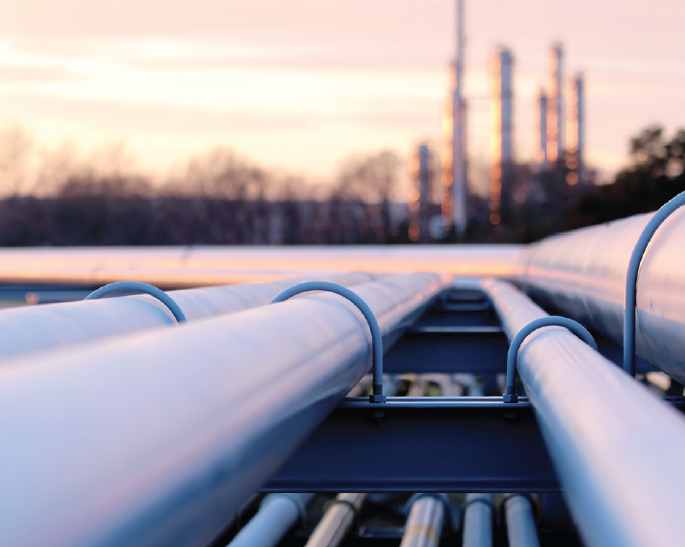
Project Summary
A Hydaburg site in Alaska, owned by Alaska Power and Telephone, previously housed diesel fuel generators and is now being converted into a hydro-electric plant. The land was contaminated by a diesel fuel spill requiring remediation. Approximately 1,000 cubic yards of soil were impacted and the starting concentrations of DRO were approximately 1 500 ppm. The goal was to reduce concentrations to below the ADEC standard of 230 ppm.
Due to the cold weather encountered during this project and the sensitive infrastructure in the area, it was important that the technology work effectively in less than ideal conditions. Also, the technology could not be corrosive nor generate excess heat. RegenOx, produces minimal heat and pressure, is non-corrosive, and works well at any temperature above freezing making it ideal for this project. Additionally, RegenOx is a chemical oxidant which quickly and effectively destroys a range of contaminants-in this case, DRO. The soil was screened with a trommel and RegenOx was mixed in a cement truck before being sprayed onto the soil. RegenOx was applied twice, with the applications spaced a week apart. This site required 20 lbs of RegenOx per cubic yard, in total 20,000 lbs.
Technology Description
RegenOx is a percarbonate-based in situ chemical oxidation technology that rapidly destroys petroleum hydrocarbons and chlorinated contaminants through powerful chemical reactions. It directly oxidizes contaminants while a catalytic component generates oxidizing free radicals to destroy the target compounds.
Results
After two applications of RegenOx, the concentrations of DRO went from 1,500 ppm to below 125 ppm, satisfying the ADEC requirement of below 230 ppm, within 8 weeks. After the remediation treatment, the soil was spread out, grass was planted and is now growing at the Hydaburg site, attesting to the renewed health of the soil.
Plume Treatment Under a Former Gas Works Site in Italy
A former gasworks site undergoing redevelopment was found to be contaminated with TPH, PAH and BTEX in the shallow formations.Read More
Integrated remediation at a motorway petrol station in Lombardia, Italy

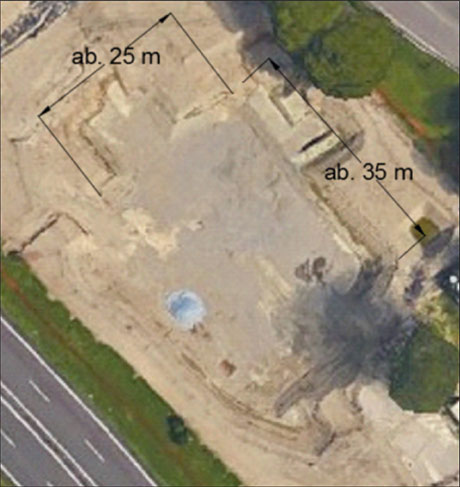
Introduction
A large petrol station located along one of the busiest motorways in northern Italy was undergoing extensive reconstruction, including the demolition of existing buildings, removal of above- and below-ground structures; as well as remediation. The existing underground fuel tanks (USTs) were removed and the contaminated soil surrounding the USTs was excavated to a depth of 5m BGL.
The geology consists of a highly permeable soil comprising sand and gravel to approx. 40m BGL. The average groundwater level is at approximately 4m to 6m BGL, where an extensive contaminant smear zone was observed.
The main excavation was approx. 1,100m2 and 5m deep, with the extent and depth limited by the proximity of the motorway (as well as the presence of groundwater).
The soil at the bottom of the excavation was highly impacted with Total Petroleum Hydrocarbons (TPHs) and BTEX compounds, with concentrations of up to 10,000mg/kg. The groundwater inside the excavation was highly contaminated, with evidence of Light Non Aqueous Phase Liquid (LNAPL) and average concentrations in the range of 500,000μg/L.





Design Approach & Planning
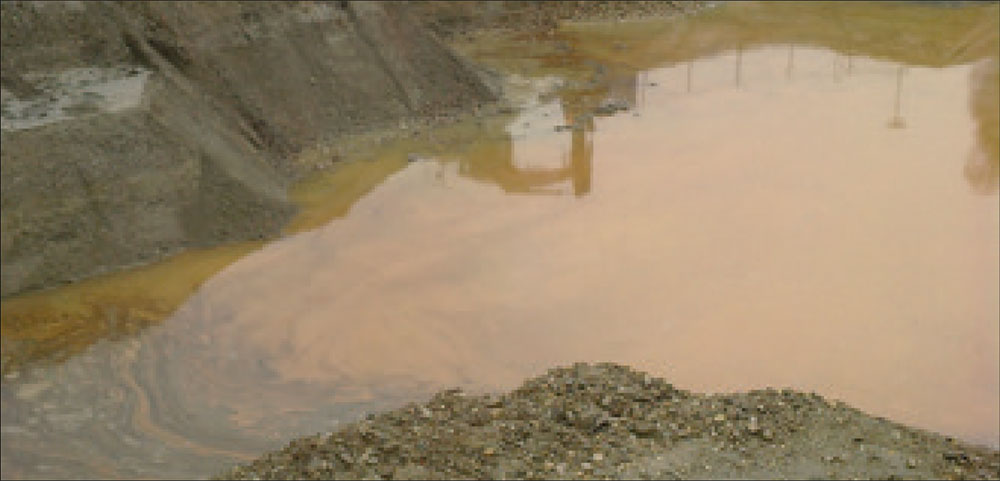 For any treatment approach on this site, to be effective in improving the groundwater quality, it would have to be able to address this secondary source in addition to treating the residual dissolved contamination. The remedial approach also needed to be rapid and effective, in order to allow for immediate back filling. This was because a delay in the construction program would result in a loss of income if the petrol station was not opened on time.
For any treatment approach on this site, to be effective in improving the groundwater quality, it would have to be able to address this secondary source in addition to treating the residual dissolved contamination. The remedial approach also needed to be rapid and effective, in order to allow for immediate back filling. This was because a delay in the construction program would result in a loss of income if the petrol station was not opened on time.
REGENESIS and the Environmental Consultant created an intelligent treatment strategy that took these challenges on board. The remediation approach comprised:
Phase I: Removal of the main contaminant mass present in the saturated soil. This was achieved via Enhanced Chemical Desorption using PetroCleanze, followed by physical abstraction using a vacuum tanker;
Phase II: In Situ biodegradation of the residual dissolved contamination over a period of 9 to 12 months following back fill, via Enhanced Aerobic Biodegradation using ORC Advanced.
 PetroCleanze has been developed by REGENESIS to enhance the desorption of contaminants from soil, so that these can be recovered by physical treatment systems. It provides a cost-effective solution for the in-situ treatment of saturated contamination and smear zones. This allows physical treatment systems to be more effective over a shorter period of time, lowering asymptotes and reducing rebound due to ongoing desorption from the smear zone.
PetroCleanze has been developed by REGENESIS to enhance the desorption of contaminants from soil, so that these can be recovered by physical treatment systems. It provides a cost-effective solution for the in-situ treatment of saturated contamination and smear zones. This allows physical treatment systems to be more effective over a shorter period of time, lowering asymptotes and reducing rebound due to ongoing desorption from the smear zone.
When applied in excavation areas, application is quick and desorbed contaminants can be recovered really easily. Usually two to three application and abstraction rounds are required to remove the bulk of the contamination. PetroCleanze is an inorganic technology and therefore avoids introducing a large oxygen demand (as occurs with using surfactants) and promotes enhanced biological degradation of the residual contamination.
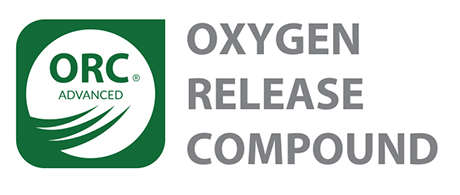 PetroCleanze has been developed by REGENESIS to enhance the desorption of contaminants from soil, so that these can be recovered by physical treatment systems. It provides a cost-effective solution for the in-situ treatment of saturated contamination and smear zones. This allows physical treatment systems to be more effective over a shorter period of time, lowering asymptotes and reducing rebound due to ongoing desorption from the smear zone.
PetroCleanze has been developed by REGENESIS to enhance the desorption of contaminants from soil, so that these can be recovered by physical treatment systems. It provides a cost-effective solution for the in-situ treatment of saturated contamination and smear zones. This allows physical treatment systems to be more effective over a shorter period of time, lowering asymptotes and reducing rebound due to ongoing desorption from the smear zone.
When applied in excavation areas, application is quick and desorbed contaminants can be recovered really easily. Usually two to three application and abstraction rounds are required to remove the bulk of the contamination. PetroCleanze is an inorganic technology and therefore avoids introducing a large oxygen demand (as occurs with using surfactants) and promotes enhanced biological degradation of the residual contamination.
Phase I – Enhanced Desorption and Extraction
- Before application, the excavation was divided in seven segments, leaving some pathways for excavator passage. For each segment, a specific PetroCleanze application dose was defined.
- PetroCleanze was applied in each sub-area through the dig and mixed directly with the remaining impacted soil. Due to the high contaminant mass present in some of the areas, LNAPL appeared on the water in less than one hour after the first application (the photos shown overleaf were taken 30 minutes after application).
- The LNAPL was subsequently removed by selective pumping using a vacuum tanker.
- Repeated soil mixing and desorbed LNAPL removal took place over the following days across the whole area (for a maximum of 3 cycles in the most contaminated areas).
- The repeated soil-mixing allowed for ongoing desorption and removal of the contamination without the need to add more PetroCleanze. This process was continued for all the sub-areas until no more recoverable free phase was present.
- Finally, a short period of de-watering was completed to remove part of the residual dissolved phase contamination, with water samples taken before and after.
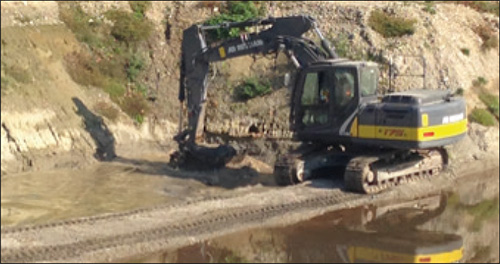
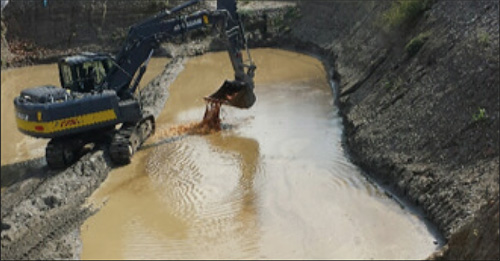
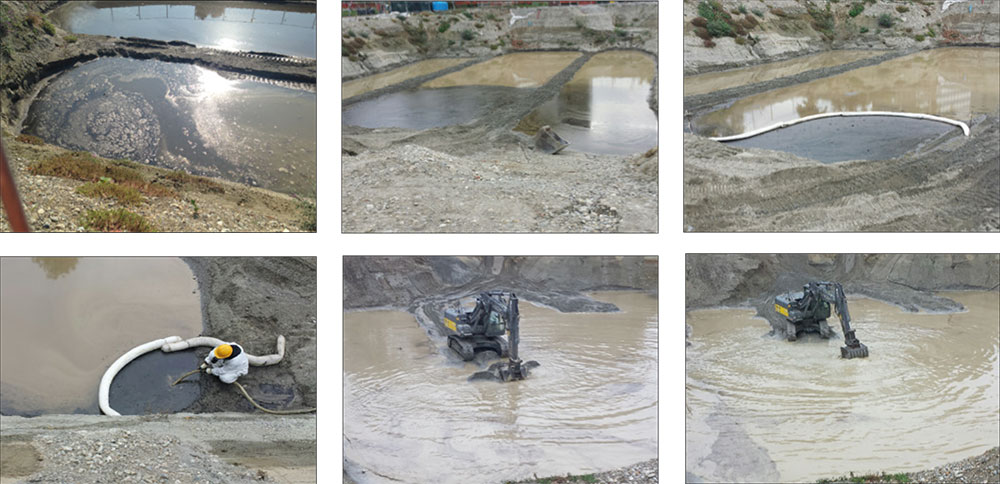
Phase II – Enhanced Aerobic Natural Attenuation
Following the initial excavation and enhanced desorption treatment, an ORC Advanced application was completed. This targeted the residual dissolved phase contamination. The ORC Advanced provided a controlled release of dissolved oxygen in order to stimulate and maintain enhanced aerobic biological degradation of the groundwater contamination for 9-12 months from the single application. This meant that the excavation could be immediately back filled and the construction continued. The remediation of the dissolved phase contamination therefore continued in situ, with no further operational costs and no disruption to the build programme.
To optimise the application process onsite, a pelletised version of ORC Advanced was chosen. This is because they can be applied directly in the excavation without the need for pre-mixing with water. The Pellets also minimise dust formation during application. The pit application was cost-effective, as it did not require additional equipment to be used on site and the application and mixing was safe, quick and straightforward.
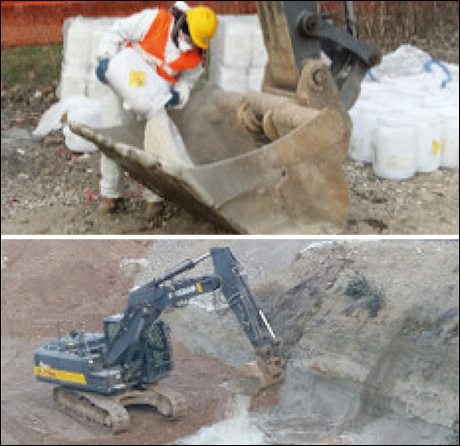
Results
- The remediation activities were completed in approximately 40 days on site, which included the product applications, soil mixing, selective pumping and final pump and treat.
- During this period, more than 400L of petroleum hydrocarbon LNAPL was successfully recovered, as well as approx. 100m3 of highly contaminated groundwater with TPH concentrations in the 100,000-1,000,000μg/L range.
- In addition, 280m3 of contaminated groundwater was removed during the final pump and treat activity (before the ORC Advanced application).
- During desorption and removal, no increase in dissolved phase concentrations was seen in the wells immediately downgradient of the excavation, or on the site boundary. This showed that all desorbed contaminants were successfully extracted during the treatment process.
- Subsequent groundwater monitoring shows a significant decrease in concentrations, avoiding any potential delay to the construction programme. The figure below shows the petroleum hydrocarbon concentrations for each sub-area at baseline (blue), during treatment (orange) and after pump and treat (grey).
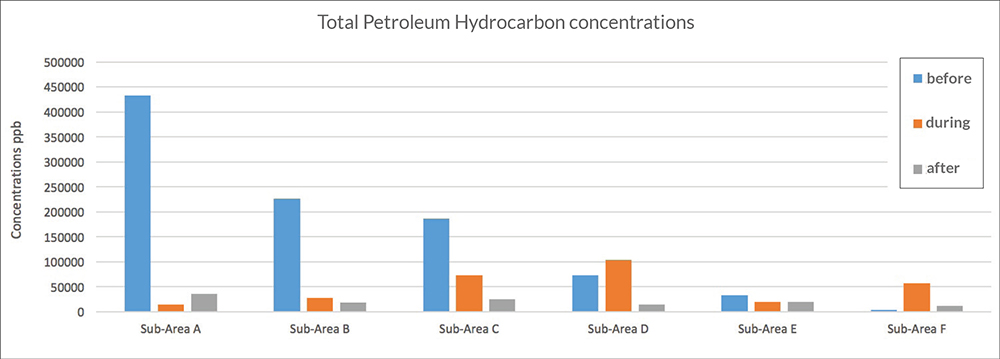
Conclusion
- The site was remediated on time without disruption to the construction program through the use of enhanced desorption and removal, followed by in situ enhanced aerobic biological degradation.
- An integrated remedial approach was created to target each contaminant type/phase, through excavation of impacted soils, enhanced desorption and extraction of LNAPL and high levels of TPH in the groundwater contamination, to biological degradation of the residual dissolved phase contamination.
- Treatment was limited to the target area with the remediation works producing no increase in downgradient contaminant concentrations.
Integrated Remediation of a Petrol Filling Station, Middlesex, UK
Integrated remediation of a former petrol station using enhanced pump and treat, excavation application and barrier injection.Read More
Rapid, Effective Remediation of Free Product at an Active Rail Depot, UK
Augmented Pump and Treat, In Situ Chemical Oxidation (ISCO) and Enhanced Natural Attenuation (ENA) completed under rail lines by REGENESIS Remediation Services. Read More
In Situ Remediation of Petroleum Hydrocarbons at Rail Depot, Bristol, UK
Surface petroleum hydrocarbon contamination had resulted from historic and on-going leaks at a train maintenance depot near Bristol, where trains were stabled overnight. REGENESIS was asked to design a remedial approach for a hotspot treatment of this contamination within one of the rail tracks.ORC Advanced Socks were installed in wells for the treatment of the dissolved phase contaminants in groundwater. The quick application showed the ease of installation, with only validation of the groundwater required to provide evidence of treatment. The ORC Advanced provided a >90% reduction in the groundwater within the hotspot area.

 Americas
Americas Europe
Europe Français
Français Deutsch
Deutsch Italiano
Italiano Español
Español